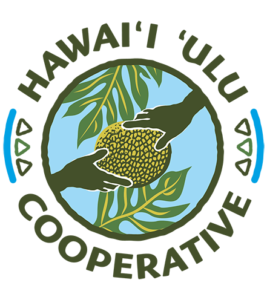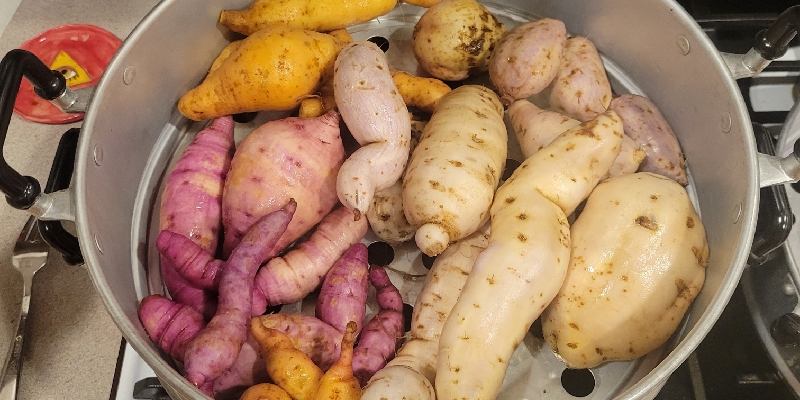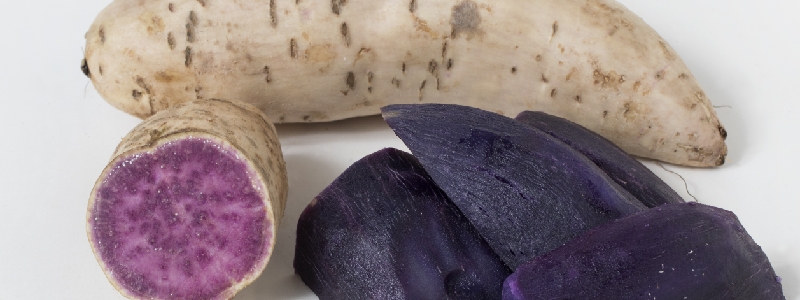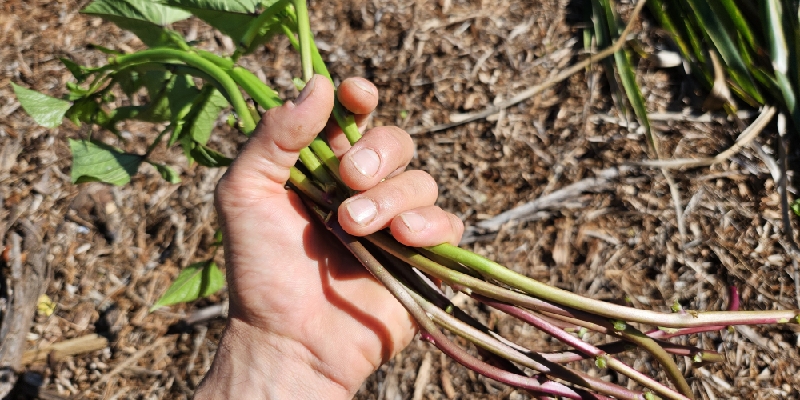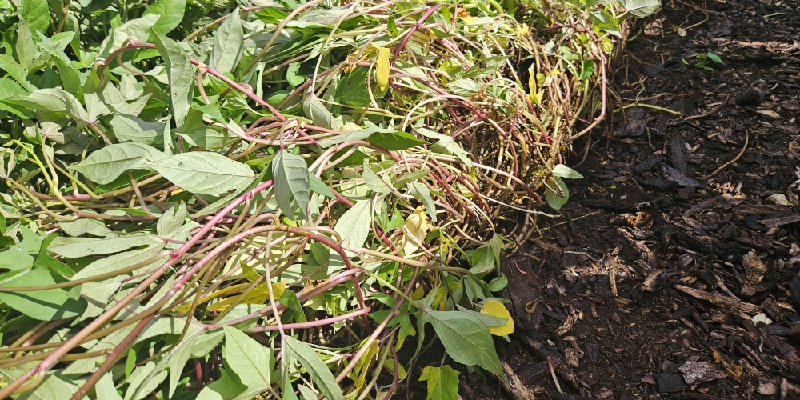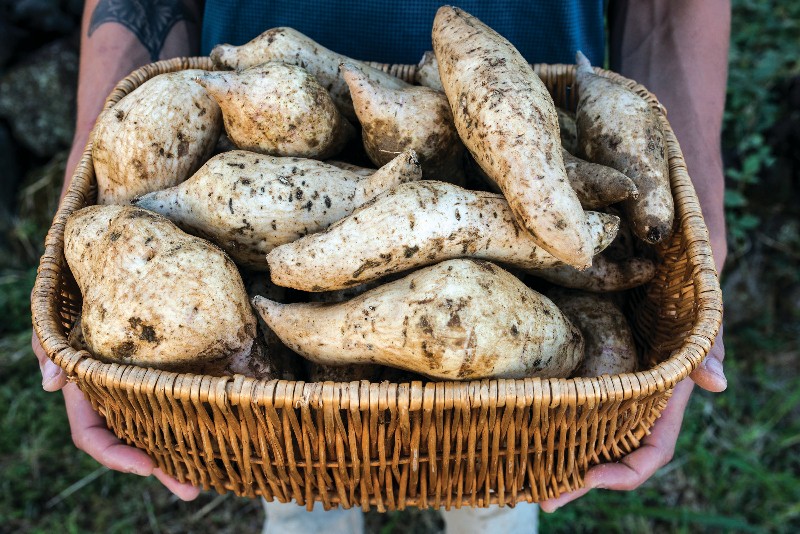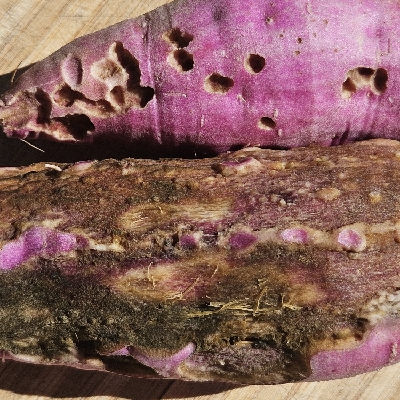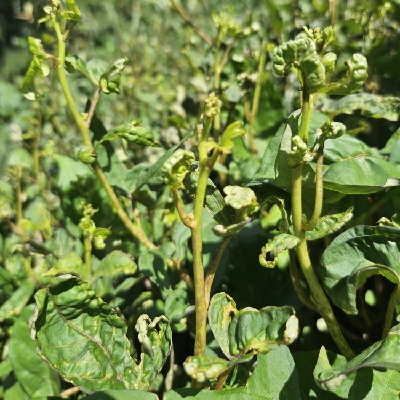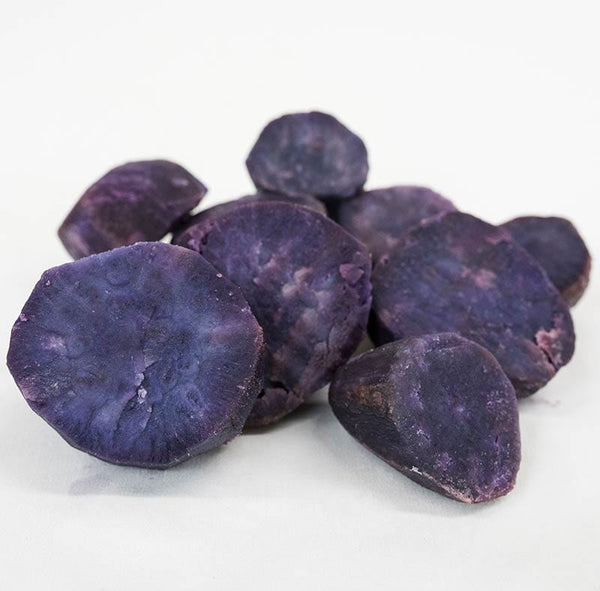Hawaiʻi Grower’s Guide to ʻUala
ʻUala, or sweet potato, is a starchy root vegetable in the morning glory family. It has been a staple crop in Hawaiʻi for centuries, and it is beloved worldwide for providing plentiful fiber, low-glycemic index carbohydrates, and an abundance of vitamins (antioxidants) A and C, potassium, calcium, and folate. Depending on the variety, the outer skin can be white, tan, orange, or purple, and the internal flesh may be orange, white, or lavender-colored.
The History of ʻUala in Hawaiʻi
There are a few theories about how ‘uala arrived to Hawaiʻi from South America as early as the late 13th century: some say that it was brought by early American voyagers or arrived by natural plant rafting, but the prevailing theory is that it was brought by the round-trip voyages of Polynesians to the Americas (Ladefoged et al. 2005; Lincoln & Vitousek 2017). In the Hawaiian Moʻolelo as recorded in The Native Planters of Old Hawaiʻi, the rain god Lono was the fourth major deity to arrive in Hawaiʻi, following Kane, Kanaloa, and Ku, and he brought ʻuala, along with ipu (gourds) and hogs to the islands (Handy et al. 1972). The arrival of ‘uala in Hawai’i led to dramatic and widespread shifts in the Hawaiian agricultural system. Due to the ‘uala’s rapid, low-maintenance growth and innate drought-resistance, Hawaiian planters were no longer limited by the water-intensive needs and limited range of kalo. As a result, dryland agriculture boomed, allowing agricultural and community expansion into drier and sandier areas that were not suitable for kalo.
ʻUala Varieties
While there are estimates of over 200 different varieties cultivated in old Hawai’i (Handy et al. 1972), with a vast array of shapes, colors, textures, and growth habits. Today, the most popular commercially grown ʻuala in Hawai’i is the ‘Okinawan’ variety, beloved for its sweet, drier purple flesh and bountiful antioxidants (Miyasaka et al. 2019). The bright purple Okinawan variety arrived in Hawaiʻi from Japan during the plantation era and quickly became a local favorite. However, the 2021 development of the new Hawaiian Heritage ‘uala are introducing new varieties that surpass the Okinawan variety’s productivity and quality. These traits, combined with the unique marketability of “Hawaiian heritage” crops, are anticipated to shift the market in the coming years (Anderson et al. 2021).
Promising Hawaiian Heritage ‘Uala Varieties:
- HM 34, a purple-fleshed variety that is high-yielding and sweet
- HM 26 is a white-fleshed variety with high yields, viable for both fresh and processing markets
Though most commercial scale ‘uala grows the okinawan or above hybrid varieties, there are working groups in Hawai’i carrying on the important work of perpetuating and studying our many native varieties. Some native ‘uala varieties are still grown at small scale and in collections like that of the National Tropical Botanical Gardens on Kaua’i which houses 30 documented varieties, which may be accessed by growers upon special request.
Planting Conditions
The climate in Hawaiʻi is ideal for the growth of ʻuala, which can be grown from altitudes of 0-2,000 feet in elevation, thriving in soil temperatures between 70 and 80 degrees Fahrenheit and atmospheric temperatures above 77 degrees Fahrenheit. While considered to be extremely drought tolerant, the young plants are most sensitive to a lack of water in the first 40 days after planting, when the root systems are small and shallow. Most cultivars of ʻuala are susceptible to waterlogging, tolerating a rainfall range of 20 to 50 inches (500 to 1300 mm) per growth cycle (~6 months, depending on cultivar) with optimal levels at 35 to 50 inches (900 to 1300 mm).
Soil Requirements
‘Uala produces its best yield in well-drained, moderately fertile, loose sandy soil, either on top of hills or on flat, well-tilled ground. The ideal pH range is between 5.5 and 6.8, ideal planting spots will have at least 12 inches of soil or compost without rocks and receive at least 6 hours of direct sunlight. Removing rocks and roots from the soil before planting will allow the roots to grow larger and be dug up more easily.
Timing the Planting Season
Contemporary research suggests that the ideal planting period for ‘uala in Hawai’i is between March and May, when the days are longer and the rainfall is less frequent (Valenzuela et al. 1994). ‘Uala is most susceptible to drought and waterlogging in the first 40 days after planting, so be sure to water your ‘uala if you are planting in times of drought, and wait to plant until after the rainy season has passed. See figure 4 below for a visualization of yields by planting month.
Propagation
ʻUala are propagated in Hawai’i from slips or cuttings (lau ʻuala) and not from botanical seed, because seed potatoes are generally much smaller and less palatable than those from cuttings. Slips can be taken from old vines and aftergrowth of small potatoes or broken tubers after a harvest season. Cuttings should be from vine ends taken 12 to 20 inches from the tip. Each slip to be planted should be about 7-8 inches long and contain 4 to 6 nodes (the junctions at which leaves or roots emerge from). It is also recommended that you take cuttings from the shorter and less aggressive vines, because those are the vines that are using most of their energy to produce roots. The longer and more luxuriant ‘uala vines tend to prioritize leaf growth over tuber growth, resulting in less food production (Handy et al. 1972).
Before planting cuttings from another field, it is critical to inspect the roots, stems, and leaves of the parent plants to ensure that they are free of pests and diseases. Using clean planting material is important to protect your ‘uala and your soil. Cuttings should always be cut above the soil line to prevent the transport of soil and root-borne disease; cuttings should never have any roots or soil attached to them (Nelson 2008). It is also possible to purchase sterile cuttings of particular varieties of ‘uala, which can help ensure disease-free starts for your farm.
Planting
Ridge Planting is the most common large scale agricultural practice, providing drainage, aeration, and puts the soil in good condition for the development of the roots. Soil should be turned 2 to 3 months prior to planting. Ridges are constructed of loose soil and vegetable matter and stand from 12 to 16 inches high, spaced 4 feet apart and with 10-12 inches between cuttings. Cuttings are placed into the open furrows by hand and then covered with the use of a single disk behind a tractor. Cuttings should be buried down to the fourth node/branching point on the vine. If your field is irrigated, place cuttings horizontally. If it is rainfed, lay the cuttings at a 45 degree angle to allow for larger roots closer to the soil surface, where the water will be moist. (Valenzuela et al. 1994).
Management
Fertilization
When fertilizing ʻuala in Hawaiʻi it is recommended to use 1 to 2 pounds of 10:20:20 N-P-K per 100 square feet; the exact needs of your ʻuala will depend on the contents and quality of your soil, but this is a good place to start. The first round of fertilizer should be applied during planting. ʻUala has a high potassium requirement, and its uptake of potassium depends on the availability of magnesium in the soil. It has a relatively low nitrogen requirement, however, and excess nitrogen can result in excessive vine growth and diminished root sizes. You can monitor the health of your plants, looking for any deformation or discoloration of the leaves, and address deficiencies as they arise (Valenzuela et al. 1994)
While synthetic fertilizers are currently cheaper and easier to source, organic alternatives for ‘uala fertilization, such as rock phosphate, guano, kelp meal, bone meal, or name brand mixes, are available and have been observed by growers in Hawai’i to result in less pressure from pests and disease.
Hilling
When using the ridge planting method, ‘uala are hilled with a disk-hiller about five weeks after planting. If you intend to split your fertilizer treatment into two parts, the second fertilizer treatment should be added to the soil just prior to the hilling. Hilling pulls soil from both sides of the row and increases the ridge height by 1-3 inches, resulting in better weed control, larger roots, and reduced damage from sweetpotato weevils (Valenzuela et al. 1994). This practice is reminiscent of the traditional Hawaiian practice Pu’e, or mounding, which ensured aeration and made time for weed removal.
Vine Turning
For all methods of ‘uala cultivation, vine turning is an important step to prevent roots from developing in the nodes of the growing vines as they touch the soil. When the vines show sturdy growth, each vine should be twisted around its base and covered firmly with pressed earth from the mounds. This prevents the plants from running wild along the ground, and directs that energy into the main root underground. Two or three vine turnings may be necessary during periods of rapid growth in moist and fertile areas. After particularly heavy rains, farmers may turn the vines back up to ensure proper drying and prevent fungal disease. (Handy et al. 1972; Valenzuela et al. 1994)
Mulching
Black plastic mulching is an optional practice for ‘uala cultivation that has been demonstrated to boost total marketable yields and shorten the time before harvest when combined with drip irrigation (Valenzuela et al. 1994). It is suggested mulching may also improve the efficiency of water and fertilizer. While mulch is widely used to suppress weeds and conserve soil moisture, there are some newly discovered benefits to certain organic mulches on the market: one recent study found that organic mulch containing plants including fresh basil, catnip, basil lime, dry eucalyptus, cypress, lucerne and sugarcane significantly reduced the presence and damage done by sweetpotato weevils to ‘uala crops (Rehman et al. 2019).
Irrigation
While ‘uala is more drought resistant and requires less water than most other crops, its yields can be increased by ~30% with proper irrigation. It is recommended that you irrigate moderately to help facilitate the establishment of ‘uala cuttings, and that you maintain a constant water supply whenever 40-50% of the field’s moisture has been depleted. Stop irrigation approximately 1 month before harvest (Valenzuela et al. 1994)
Harvesting & Best Practices
ʻUala is harvested as soon as the roots reach marketable size, usually 4-6 months after planting depending on variety, time of planting and/or environmental conditions. Rotary or flail-type mowers can be used to mow the vines at the base. Vines are then removed or rolled into adjacent rows before harvesting. The roots are spaded out by hand or plowed with a middlebuster/modified potato harvester. Roots are then selected, packed, and transported to a harvest facility for washing; in wet soil, allow the soil on the roots to dry naturally in a shaded area before gently removing it by hand. It is important to handle the roots carefully to prevent damage, cuts, and bruises; these injuries facilitate the spread of post-harvest diseases that can devastate crops (Valenzuela et al. 1994).
Healthy Planting Materials & Sterile Conditions
To prevent the spread of pests and diseases, it is important to only plant healthy slips from pest and disease-free ‘uala fields. This ensures that the plant material you are introducing to your fields is healthy, and gives your fields a better chance of staying healthy throughout the growing season. Be sure to sterilize all of your planting and harvesting equipment to further prevent the spread of pests and diseases between fields and plants.
Crop Rotations
To prevent the proliferation of pests and diseases, ‘uala should only be planted in a given field once every 3 to 4 years. When a field is harvested or a diseased plant is removed, it is important not to leave any ‘uala roots in the field where those pests and diseases can proliferate; the leftover vines and foliage make excellent hog feed.
Expected Yields
When properly fertilized and tended, ʻuala plants yield between 15,000 to 20,000 pounds per acre. On a smaller scale, 100 plants spaced 4 by 2 feet apart should produce at least 150 pounds of sellable and 50 pounds of cull roots.
Pests & Diseases
For more information and photos of the pests and diseases that affect ʻuala in Hawaiʻi, check out the Sweet Potato Production Guides for Hawaiʻi.
